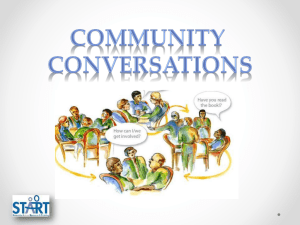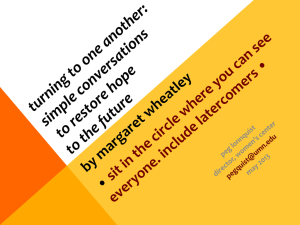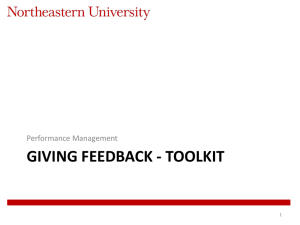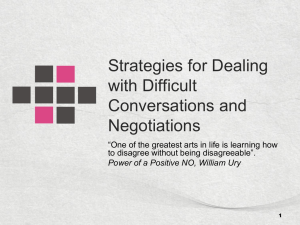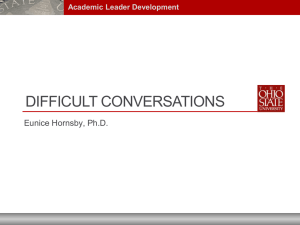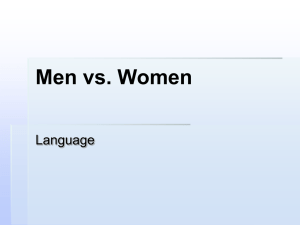Crucial Conversations
advertisement
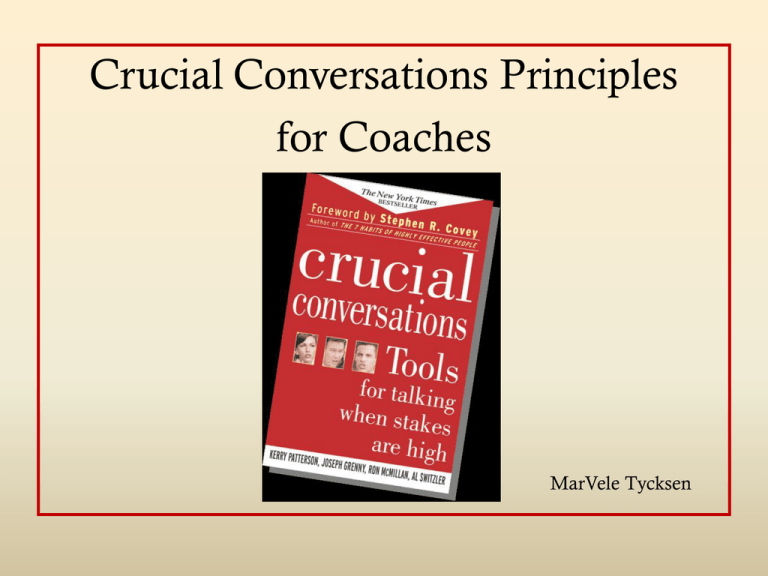
Crucial Conversations Principles for Coaches MarVele Tycksen Handouts: Worksheet Language of a Mentor A Protocol to get “Unstuck” (Communicating in Crucial Conversations) Procedure for collaboration: Assignment Return prompt - 5 seconds Session Objectives • Explore elements of a crucial conversation • Learn about your own style under stress • Learn strategies to use in coaching interactions Crucial Conversation Principles • • • • • • • • Get Unstuck - CPR Start with Heart Learn to Look Make it Safe Master My Stories STATE My Path Explore Others’ Paths Move to Action Work on Me First Focus with Others A true coach helps those they mentor, to do more, see more, and become more than they could become on their own. So what do you do when your mentee…. …..resists your help? When they: • …think they know it all….. • …rationalize their poor performance…. • or…….. …tell you what you want to hear, and then do their own thing…. Would you like some help? Think of a teacher that you will consider through the training. Find a table partner and share it with them. What is a crucial conversation? Ron McMillan Crucial Conversations have: Opposing Opinions Strong Emotions High Stakes When it Matters Most, We Do the Worst …. sugarcoat the conversation …or run from them …ramrod them The best, resolve conversations through dialogue What conversations are you not holding, or not holding well? Style Under Stress Survey Review your survey, what is your style of response? Silence or Violence ? silence violence During Crucial Conversations parts of the brain shut down so, we are left to deal with complex social problems with the same set of skills we would use to deal with a ferocious animal. It is our… Reptilian Brain Think of your teacher …… How does your style impact your coaching? Values that Kill Dialogue Save Face Keep the peace Win Be Right Look Good Avoid Conflict When the conversation becomes crucial, slow down. Stop. Look. Listen. Lets explore strategies that will help with crucial conversations while we are coaching… Crucial Conversation Principles • Get Unstuck - CPR • Start with Heart • Learn to Look • Make it Safe • Master My Stories • STATE My Path • Explore Others’ Paths • Move to Action Work on Me First Focus with Others CPR Joseph Grenny, Author True Story of resistant teacher, part I Observation 1 data: 37 disruptions Post Conference • Content multiple disruptions Observation 2, data: high rates of off task behavior Post Conference What is the problem? Does the conversation need to change from Content to Pattern? • Pattern poor classroom management not accepting results Observation 3 students out of seats, etc. Post Conference Does the conversation need to change again? • Relationship lack the ability? not value the results of the observations? do not respect your expertise? Review of CPR: • Content • Pattern or Process • Relationship If the content level conversation is not getting results move to pattern and then relationship. Think of your teacher …… Are you holding the right conversation? How do you know? Crucial Conversation Principles • Get Unstuck - CPR • Start with Heart • Learn to Look • Make it Safe • Master My Stories • STATE My Path • Explore Others’ Paths • Move to Action Work on Me First Focus with Others Start with Heart “Work on Me First, Us Second” Ask: What do you want? True Story of resistant teacher, part II What do you really want? Start With heart: Learn Find the Truth Produce Results Strengthen Relationships Review Start with Heart Focus on what you really want? Think of the teacher that you are considering…… What do you really want ? Crucial Conversation Principles • Get Unstuck - CPR • Start with Heart • Learn to Look • Make it Safe • Master My Stories • STATE My Path • Explore Others’ Paths • Move to Action Work on Me First Focus with Others Learn to Look During normal conversations we use a third eye –Two eyes and ears attend to the content of the conversation (the what). –Another eye watches the conditions of the conversation (the how). What do you notice about yourself when you are nervous or on the spot? • • • • • • Tense shoulders Heat turned up (flushing, sweating) Stomach ache Go Silent Roll Eyes Look Down Look for these behaviors in the teacher. Remember! When you see these signs, slow down. Stop. Look. Listen. Crucial Conversation Principles • Get Unstuck - CPR • Start with Heart • Learn to Look • Make it Safe • Master My Stories • STATE My Path • Explore Others’ Paths • Move to Action Work on Me First Focus with Others Make it Safe Learn to Look for safety problems body language looking away silence sarcastic remarks walks away intonation in voice Make it Safe People who look at safety and content during crucial conversations can get to dialogue about almost anything. Those who don’t, try to fix what goes wrong in exactly the wrong way. Story Part III SUU Observation Went to silence…. Eyes down "My lesson is completely different." Start with heart Learn to Look Make it Safe Step out of the conversation Apologize and Contrasting Statement: Review Make it Safe What do you do if it becomes unsafe? • Step out of the conversation • Apologize • Use a Contrasting statement –Contrasting is a “Don’t/Do” Statement Think of the teacher that you are considering…… What will you do if you suspect safety is problem? Story Part IV Copy of email On Mon, 04 Oct 2010 10:08:13 -0600 __(teacher )wrote: "MarVele, I got all 3s on my evaluation with the student principal and the (principal's name) even came in for a few minutes to observe. Thanks for your note and all your help. They said I did a great job and to keep doing what I am doing." A true coach helps those they mentor, to do more, see more, and become more than they could become on their own. Review the principles of Crucial Conversations: • • • CPR (content, pattern, relationship) Start With Heart Learn to Look Make It Safe Our Session Objectives were: Explore elements of a crucial conversation Learn about your own style under stress Learn strategies to use in coaching interactions • NOW… • Assignment : At our next UCN meeting be prepared to return & report on how you used these principles in your coaching interactions? Use the notes, protocol, and mentor language, pages and practice using the principles.

